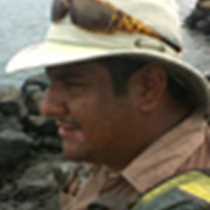“Good morning, good morning,” was our wakeup call. We were anchored at Academy Bay in Puerto Ayora. This town, economical capital of the archipelago, is located at the southern part of Santa Cruz Island, which is the second biggest island in the archipelago with one extension that rises to 864 meters high. Santa Cruz has different ecosystems that range from the littoral zone, which is full of mangroves, cacti to the humid and evergreen highlands where tall trees and endemic species like Miconia and Scalecia inhabit this vegetation zone. In addition, forty eight fern species and a handful of orchids live at this altitude as well. Unfortunately there is interspecific competition within the endemic and dome introduced plant species as the blackberry and guava. These invasive plants have a huge quantity of seeds that are dispersed by Darwin finches and other bird species.
At this time of the year we always expect some rain but today in the morning it was very sunny and humid. During the walk around the Charles Darwin Research Center we found several species of endemic land birds like Darwin Finches and Yellow Warblers which happen to be the only bright yellow bird found in the Galapagos. We spotted the Galapagos mockingbird as well. The latter was the last species of mockingbird that we had not seen yet. During this week we have seen the other three species that live in the Galapagos: the San Cristobal, Española and the Floreana Mockingbirds.
Later, as we were walking along Puerto Ayora, we visited the fishing dock of the town. Galapagos fishermen were selling Yellow-fined Tunas and other fish species. Not only were people passing by, but there were many Brown pelicans and Galapagos sea lions as well. In addition to the wonderful experience with the local fishermen it was amazing to witness how the “Galapagueños” peacefully interact with the islands’ wildlife.
Our expedition leader Carlos Romero was waiting for us at the Silberstein Hotel to greet and organize us to send us by bus to the highlands of Santa Cruz. Before having lunch we visited an organic farm that has coffee and sugar cane plantations. Mr. Adriano Cabrera, owner of this amusing place, opened his farm to let us know that there are innovative alternatives to improve the quality of life and economy of the Galapagos. By the way, this farm was perfect for our younger explorers this week, for they were learning and discovering first-hand many new things about how sugar cane and coffee products are made. As soon as we finished a delicious sugar cane juice glass and a coffee cup we headed to a local ranch, “El Chato.” This property was located on the central western side of Santa Cruz Island, where we had our lunch. During lunch I observed so many happy guests’ faces. Young explorers enjoyed playing ping pong in one of the corners of the picturesque restaurant. After lunch we went to the nearby tortoise reserve to observe these giant animals in the wild.
During the walk, we had the thrill to cross a lava tunnel that gave us understanding of some geological events that produce this kind of formation. The formation of this tunnel is very interesting: when a volcanic eruption occurred the lava flows cool off in the outer layer areas leaving a channel in the middle where red hot lava in liquid state and still in movement continue to run in the formed tube. At one point the lava flow ceases to run leaving an empty space that was extensively used during the pirates and whalers’ times in the last centuries.
We had a great day sharing magical moments with giant tortoises and with the “Galapagueños” that ended with live music and dancing performed by a local band and female dancers who came onboard to entertain us, making a golden finale for an unforgettable day in paradise.



.jpg?width=106&height=85&mode=crop&scale=both&quality=50)



